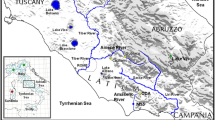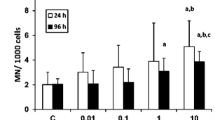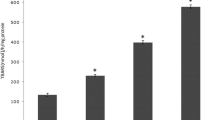Abstract
Arsenic (As) contamination of freshwater is largely due to geogenic processes, but As is also released into the environment because of improper anthropic activities. The European regulatory limits in drinking water are of 10 μg L−1 As. However, knowledge of the genotoxic effects induced by low doses of As in freshwater environments is still scanty. This study was designed to investigate arsenate (As(V)) and arsenite (As(III)) toxicity and low-dose genotoxicity in Gammarus elvirae, which has proved to be a useful organism for genotoxicity assays in freshwater. As(V) and As(III) toxicity was assessed on the basis of the median lethal concentration, LC(50), while estimates of DNA damage were based on the Comet assay. The G. elvirae LC (50–240 h) value we calculated was 1.55 mg L−1 for As(V) and 1.72 mg L−1 for As(III). Arsenic exposure (240 h) at 5, 10, and 50 µg L−1 of As in assays with either arsenate or arsenite-induced DNA damage in hemocytes of G. elvirae in a concentration-dependent manner. Our study provides a basis for future genotoxic research on exposure to freshwater that contains low levels of arsenic.



Similar content being viewed by others
References
Ahmed MK, Al Mamun MH, Hossain MA, Arif M, Parvin E, Akter MS, Khan MS, Islam MM (2011) Assessing the genotoxic potentials of arsenic in tilapia (Oreochromis mossambicus) using alkaline comet assay and micronucleus test. Chemosphere 84:143–149
Akram Z, Jalali S, Shami SA, Ahmad L, Batool S, Kalsoom O (2009) Genotoxicity of sodium arsenite and DNA fragmentation in ovarian cells of rat. Toxicol Lett 190:81–85
Ali D, Nagpure NS, Kumar S, Kumar R, Kushwaha B, Lakra WS (2009) Assessment of genotoxic and mutagenic effects of chlorpyriphos in freshwater fish Channa punctatus (Bloch) using micronucleus assay and alkaline single-cell gel electrophoresis. Food Chem Toxicol 47:650–656
Bach J, Peremartí J, Annangi B, Marcos R, Hernández A (2015) Reduced cellular DNA repair capacity after environmentally relevant arsenic exposure. Influence of Ogg1 deficiency. Mutat Res 779:144–151
Bach J, Peremartí J, Annangi B, Marcos R, Hernández A (2016) Oxidative DNA damage enhances the carcinogenic potential of in vitro chronic arsenic exposures. Arch Toxicol 90:1893–1905
Borghini A, Faita F, Mercuri A, Minichilli F, Bustaffa E, Bianchi F, Andreassi MG (2016) Arsenic exposure, genetic susceptibility and leukocyte telomere length in an Italian young adult population. Mutagenesis 31:539–546
Bustaffa E, Stoccoro A, Bianchi F, Migliore L (2014) Genotoxic and epigenetic mechanisms in arsenic carcinogenicity. Arch Toxicol 88:1043–1067
Button M, Jenkinb GRT, Bowman KJ, Harringtond CF, Brewerb TS, Jonesc GDD, Wattsa MJ (2010) DNA damage in earthworms from highly contaminated soils: Assessing resistance to arsenic toxicity by use of the Comet assay. Mutat Res 696:95–100
Canivet V, Chambon P, Gibert J (2001) Toxicity and bioaccumulation of arsenic and chromium in the epigean and hypogean freshwater macroinvertebrates. Arch Environ Contam Toxicol 40:345–354
Cappelletti R, Ceppi M, Claudatus J, Gennaro V (2016) Health status of male steel workers at an electric arc furnace (EAF) in Trentino, Italy. J Occup Med Toxicol 11:7
Cavalca L, Zanchi R, Corsini A, Colombo M, Romagnoli C, Canzi E, Andreoni V (2010) Arsenic-resistant bacteria associated with roots of the wild Cirsium arvense (L.) plant from an arsenic polluted soil, and screening of potential plant growth-promoting characteristics. Syst Appl Microbiol 33:154–164
Cavalca L, Corsini A, Canzi E, Zanchi R (2015) Rhizobacterial communities associated with spontaneous plant species in long-term arsenic contaminated soils. World J Microbiol Biotechnol 31:735–746
Censi P, Sposito F, Inguaggiato C, Venturi M, Censi V, Falcone EE (2016) Weathering of evaporites: natural versus anthropogenic signature on the composition of river waters. Rend Fis Acc Lincei 27:29–37
Chakraborti D, Rahman MM, Ahamed S, Dutta RN, Pati S, Mukherjee SC (2016) Arsenic contamination of groundwater and its induced health effects in Shahpur block, Bhojpur district, Bihar state, India: risk evaluation. Environ Sci Pollut Res Int 23:9492–9504
Coelho P, García-Lestón J, Costa S, Costa C, Silva S, Dall’Armi V, Zoffoli R, Bonassi S, de Lima JP, Gaspar JF, Pásaro E, Laffon B, Teixeira JP (2013) Genotoxic effect of exposure to metal(loid)s. A molecular epidemiology survey of populations living and working in Panasqueira mine area, Portugal. Environ Int 60:163–170
Colombani N, Mastrocicco M, Prommer H, Sbarbati C, Petitta M (2015) Fate of arsenic, phosphate and ammonium plumes in a coastal aquifer affected by saltwater intrusion. J Contam Hydrol 179:116–131
Cremisini C, Armiento G (2016) High geochemical background of potentially harmful elements. The “geochemical risk” and “natural contamination” of soils and water: awareness and policy approach in Europe with a focus on Italy. Rend Fis Acc Lincei 27:7–20
Cullen WR, Reimer KJ (1989) Arsenic speciation in the environment. Chem Rev 89:713–764
Davolos D, Pietrangeli B (2013) A molecular study on bacterial resistance to arsenic-toxicity in surface and underground waters of Latium (Italy). Ecotoxicol Environ Saf 96:1–9
Davolos D, Chimenti C, Ronci L, Setini A, Iannilli V, Pietrangeli B, De Matthaeis E (2015) An integrated study on Gammarus elvirae (Crustacea, Amphipoda): perspectives for toxicology of arsenic-contaminated freshwater. Environ Sci Pollut Res Int 22:15563–15570
D’Ippoliti D, Santelli E, De Sario M, Scortichini M, Davoli M, Michelozzi P (2015) Arsenic in drinking water and mortality for cancer and chronic diseases in Central Italy, 1990-2010. PLoS ONE 10:e0138182
Di Donato G, De Matthaeis E, Ronci L, Setini A (2016) Genotoxicity biomarkers in the amphipod Gammarus elvirae exposed in vivo to mercury and lead, and basal levels of DNA damage in two cell types. Chem Ecol 32:9. doi:10.1080/02757540.2016.1201078
Fan W, Ren J, Li X, Wei C, Xue F, Zhang N (2015) Bioaccumulation and oxidative stress in Daphnia magna exposed to arsenite and arsenate. Environ Toxicol Chem 34:2629–2635
Ferrario D, Gribaldo L, Hartung T (2016) Arsenic exposure and immunotoxicity: a review Including the possible influence of age and sex. Curr Environ Health Rep 3:1–12
García-Hernández J, Hurtado LA, Leyva-García G, Güido-Moreno A, Aguilera-Márquez D, Mazzei V, Ferrante M (2015) Isopods of the genus Ligia as potential biomonitors of trace metals from the gulf of California and pacific coast of the Baja California peninsula. Ecotoxicol Environ Saf 112:177–185
Gutiérrez L, Garbisu C, Ciprián E, Becerril JM, Soto M, Etxebarria J, Madariaga JM, Antigüedad I, Epelde L (2015) Application of ecological risk assessment based on a novel TRIAD-tiered approach to contaminated soil surrounding a closed non-sealed landfill. Sci Total Environ 514:49–59
He W, Megharaj M, Naidu R (2009) Toxicity of tri- and penta-valent arsenic, alone and in combination, to the cladoceran Daphnia carinata: the influence of microbial transformation in natural waters. Environ Geochem Health 31 Suppl 1:133–141
Hose GC, Symington K, Lott MJ, Lategan MJ (2016) The toxicity of arsenic(III), chromium(VI) and zinc to groundwater copepods. Environ Sci Pollut Res Int 23:18704–18713
Kozul CD, Hampton TH, Davey JC, Gosse JA, Nomikos AP, Eisenhauer PL, Weiss DJ, Thorpe JE, Ihnat MA, Hamilton JW (2009) Chronic exposure to arsenic in the drinking water alters the expression of immune response genes in mouse lung. Environ Health Perspect 117:1108–1115
Kračun-Kolarević M, Kolarević S, Jovanović J, Marković V, Ilić M, Simonović P, Simić V, Gačić Z, Diamantini E, Stella E, PetrovićM, Majone B, Bellin A, Paunović M, Vuković-Gačić B (2016) Evaluation of genotoxic potential throughout the upper and middle stretches of Adige river basin. Sci Total Environ 571:1383–1391
Kumaravel TS, Jha AN (2006) Reliable Comet assay measurements for detecting DNA damage induced by ionising radiation and chemicals. Mutat Res 605(1–2):7–16
Lacaze E, Geffard O, Bony S, Devaux A (2010) Genotoxicity assessment in the amphipod Gammarus fossarum by the use of the alkaline comet assay. Mutat Res 700:32–38
Lantz RC, Hays AM (2006) Role of oxidative stress in arsenic-induced toxicity. Drug Metab Rev 38:791–804
Lapanje A, Drobne D, Nolde N, Valant J, Muscet B, Leser V, Rupnik M (2008) Long-term Hg pollution induced Hg tolerance in the terrestrial isopod Porcellio scaber (Isopoda, Crustacea). Environ Pollut 153:537–547
Liber K, Doig LE, White-Sobey SL (2011) Toxicity of uranium, molybdenum, nichel, and arsenic to Hyalella azteca and Chironomus dilutus in water-only and spiked-sediment toxicity. Ecotoxicol Environ Saf 74:1171–1179
Liu X, Sun B, Wang X, Nie J, Chen Z, An Y, Tong J (2016) Synergistic effect of radon and sodium arsenite on DNA damage in HBE cells. Environ Toxicol Pharmacol 41:127–131
Marcoccia M, Ronci L, De Matthaeis E, Setini A, Perrino C, Canepari S (2017) In-vivo assesment of the genotoxic and oxidative stress effects of particulate matter on Echinogammarus veneris. Chemosphere 173:124–134. doi:10.1016/j.chemosphere.2017.01.019
Nasser NA, Patterson RT, Roe HM, Galloway JM, Falck H, Palmer MJ, Spence C, Sanei H, Macumber AL, Neville LA (2016) Lacustrine Arcellinina (Testate Amoebae) as bioindicators of arsenic contamination. Microb Ecol 72:130–149
Oremland RS, Stolz JF (2003) The ecology of arsenic. Science 300:939–944
Preziosi E, Rossi D, Parrone D, Ghergo S (2016) Groundwater chemical status assessment considering geochemical background: an example from Northern Latium (Central Italy). Rend Fis Acc Lincei 27:59–66
Protano C, Astolfi ML, Canepari S, Vitali M (2016) Urinary levels of trace elements among primary school-aged children from Italy: The contribution of smoking habits of family members. Sci Tot Environ 557:378–385
Qu W, Waalkes MP (2015) Metallothionein blocks oxidative DNA damage induced by acute inorganic arsenic exposure. Toxicol Appl Pharmacol 282:267–274
Ronci L, Iannilli V, De Matthaeis E, Di Donato G, Setini A (2015) Evaluation of genotoxic potential of waters from two Italian tivers in Gammarus elvirae (Amphipoda). Water Environ Res 87:2008–2017
Sánchez MI, Petit C, Martínez-Haro M, Taggart MA, Green AJ (2016) May arsenic pollution contribute to limiting Artemia franciscana invasion in southern Spain? PeerJ 4:e1703. 2016
Schaller J, Koch I, Caumette G, Nearing M, Reimer KJ, Planer-Friedrich B (2015) Strategies of Gammarus pulex L. to cope with arsenic—Results from speciation analyses by IC–ICP-MS and XAS micro-mapping. Sci Total Environ 530-531:430–433
Shaw JR, Glaholt SP, Greenberg NS, Sierra-Alvarez R, Folt CL (2007) Acute toxicity of arsenic to Daphnia pulex: influence of organic functional groups and oxidation state. Environ Toxicol Chem 26:1532–1537
Singha U, Pandey N, Boro F, Giri S, Giri A, Biswas S (2014) Sodium arsenite induced changes in survival, growth, metamorphosis and genotoxicity in the Indian cricket frog (Rana limnocharis). Chemosphere 112:333–339
Smedley PL, Kinniburgh DG (2002) A review of the source, behaviour and distribution of arsenic in natural waters. Appl Geochem 17:517–568
Stea F, Faita F, Borghini A, Faita F, Bianchi F, Bustaffa E, Minichilli F, Andreassi MG, Sicari R (2016) Arsenic and subclinical vascular damage in a sample of Italian young adults: a cross-sectional analysis. Environ Sci Pollut Res Int 23:20307–20314
Stojak A, Bonnevie NL, Jones DS (2015) Evaluation of metals, metalloids, and ash mixture toxicity using sediment toxicity testing. Integr Environ Assess Manag 11:21–31
Straub AC, Clark KA, Ross MA, Chandra AG, Li S, Gao X, Pagano PJ, Stolz DB, Barchowsky A (2008) Arsenic-stimulated liver sinusoidal capillarization in mice requires NADPH oxidase–generated superoxide. J Clin Invest 118:3980–3989
Tchounwou PB, Centeno JA, Patlolla AK (2004) Arsenic toxicity, mutagenesis, and carcinogenesis – a health risk assessment and management approach. Mol Cell Biochem 255:47–55
Ternjej I, Mihaljevic Z, Ivkovic M, Previsic A, Stankovic I, Maldini K, Zeljezic D, Kopjar N (2014) The impact of gypsum mine water: a case study on morphology and DNA integrity in the freshwater invertebrate, Gammarus balcanicus. Environ Pollut 189:229–238
Vellinger C, Parant M, Rousselle P, Usseglio-Polatera P (2012) Antagonistic toxicity of arsenate and cadmium in a freshwater amphipod (Gammarus pulex). Ecotoxicology 21:1817–1827
Vellinger C, Gismondi E, Felten V, Rousselle P, Mehennaoui K, Parant M, Esseglio-Polatera P (2013) Single and combined effects of cadmium and arsenate in Gammarus pulex (Crustacea, Amphipoda): understanding the links between physiological and behavioural responses. Aquat Toxicol 140-141:106–116
Weber L, Carvalho L, Sá N, Silva V, Beraldini N, Souza V, Conceição M (2013) Genotoxic effects of the water-soluble fraction of heavy oil in the brackish/freshwater amphipod Quadrivisio aff. lutzi (Gammaridea) as assessed using the comet assay. Ecotoxicology 22:642–655
Williams G, West JM, Koch I, Reimer KJ, Snow ET (2009) Arsenic speciation in the freshwater crayfish, Cherax destructor Clark. Sci Total Environ 407:2650–2658
Wu X, Cobbina SJ, Mao G, Xu H, Zhang Z, Yang L (2016) A review of toxicity and mechanisms of individual and mixtures of heavy metals in the environment. Environ Sci Pollut Res Int 23:8244–8259
Xu H, Zhou X, Wen X, Lauer FT, Liu KJ, Hudson LG, Aleksunes LM, Burchiel SW (2016) Environmentally-relevant concentrations of arsenite induce dose-dependent differential genotoxicity through poly(ADP-ribose) polymerase (PARP) inhibition and oxidative stress in mouse thymus cells. Toxicol Sci 149:31–41
Acknowledgements
We thank Marco Gramiccioni for his help in sampling G. elvirae specimens within the river system, and Sapienza University of Rome (Rome, Italy) for its financial support. We would also like to thank Silvia Canepari (Department of Chemistry, Sapienza University of Rome) for her suggestions and assistance in measuring the real concentrations of As by means of inductively coupled plasma mass spectrometry. Anonymous reviewers provided high quality advice that improved the manuscript.
Author information
Authors and Affiliations
Corresponding author
Ethics declarations
Conflict of interest
The authors declare that they have no competing interests.
Rights and permissions
About this article
Cite this article
Ronci, L., De Matthaeis, E., Chimenti, C. et al. Arsenic-contaminated freshwater: assessing arsenate and arsenite toxicity and low-dose genotoxicity in Gammarus elvirae (Crustacea; Amphipoda). Ecotoxicology 26, 581–588 (2017). https://doi.org/10.1007/s10646-017-1791-6
Accepted:
Published:
Issue Date:
DOI: https://doi.org/10.1007/s10646-017-1791-6




